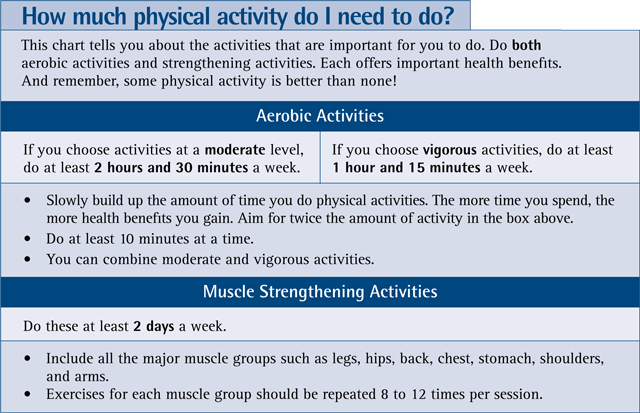Topics
Additional health advice:
Physical Activity for Everyone
Many people wonder how much physical activity they should do. National public health physical activity recommendations have been set for children and adolescents, adults, older adults and even special populations, such as pregnant women. Even if you don’t have a 30 minute window to dedicate to going for a walk or jog, that doesn’t mean you can’t add physical activity to your day. Think about physical activity as a lifestyle choice and look for ways to build more activity into your daily routine. Increasing your physical activity is one of the best things you can do for your physical and mental health and by making it a priority in your life, you’ll be more likely to stick with it over the long-term and reap its benefits!
Recommendations do differ by age and other special conditions. See below for recommendations by group.
Adults
Below are the recommendations for MOST adults (Source: Be Active Your Way. A Guide for Adults).

For even greater health benefits, adults can aim to increase their activity to 300 minutes (5 hours) of moderate intensity physical activity or 150 minutes of vigorous intensity physical activity each week and perform muscle strengthening activities on 2 or more days per week. Consider breaking up your physical activity into smaller chunks of time throughout the day. For the greatest health benefits, activity should be done at a moderate or vigorous level for at least 10 minutes at a time.
To learn more about recommendations for adults, visit the Physical Activity Guidelines for Americans website.
Children and Adolescents (ages 6-17)
Here is a summary of recommendations for children and adolescents (Source: Physical Activity Guidelines for Americans).
Key Guidelines for Children and Adolescents
- Children and adolescents should do 60 minutes (1 hour) or more of physical activity daily.
- Aerobic: Most of the 60 or more minutes a day should be either moderate- or vigorous-intensity aerobic physical activity, and should include vigorous-intensity physical activity at least 3 days a week.
- Muscle-strengthening: As part of their 60 or more minutes of daily physical activity, children and adolescents should include muscle-strengthening physical activity on at least 3 days of the week.
- Bone-strengthening: As part of their 60 or more minutes of daily physical activity, children and adolescents should include bone-strengthening physical activity on at least 3 days of the week.
- It is important to encourage young people to participate in physical activities that are appropriate for their age, that are enjoyable, and that offer variety.
To learn more about recommendations for children and adolescents, visit the Physical Activity Guidelines for Americans website.
Pregnant or Postpartum Women
According to the 2008 Physical Activity Guidelines for Americans, it is safe for most healthy pregnant women to be physically active. Healthy women should get at least 150 minutes (2 hours and 30 minutes) per week of moderate-intensity aerobic activity, such as brisk walking, during and after their pregnancy. It is best to spread this activity throughout the week.
Healthy women who already do vigorous-intensity aerobic activity, such as running, or large amounts of activity can continue doing so during and after their pregnancy provided they stay healthy and discuss with their health care provider how and when activity should be adjusted over time.
If you are pregnant, you can consult the current physical activity guidelines for additional advice.
Older Adults
Older adults (65 years of age or older) who are generally fit and have no limiting health conditions can follow the guidelines listed above for adults (Physical Activity Guidelines for Americans, 2008).
When older adults cannot meet the general guidelines for adults (150 minutes of moderate-intensity aerobic activity a week), they should be as physically active as their abilities and conditions allow. Older adults should also do exercises that maintain or improve balance if they are at risk of falling. Older adults should determine their level of effort for physical activity relative to their level of fitness. Finally, older adults with chronic conditions should understand whether and how their conditions affect their ability to do regular physical activity safely.
For more information about physical activity for older adults, please refer to the guidelines.
For Everyone
For all individuals, some activity is better than none! If you are not currently active, then your goal should be to start low and go slow! That is, break up your activity into small bouts and start with lower intensities, and build slowly over time.
For more information about the national public health physical activity guidelines, watch the brief video clip below.